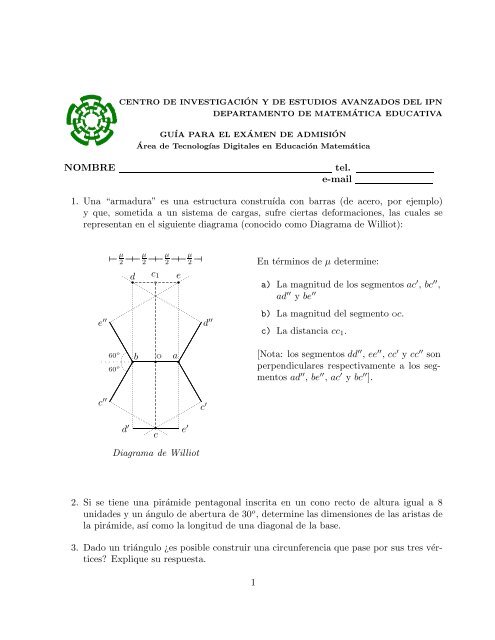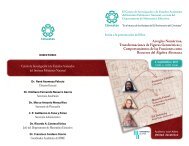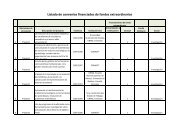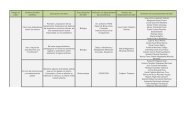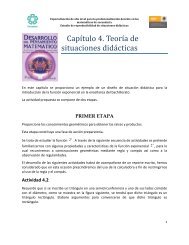Examen Muestra 1 - Departamento de Matemática Educativa
Examen Muestra 1 - Departamento de Matemática Educativa
Examen Muestra 1 - Departamento de Matemática Educativa
Create successful ePaper yourself
Turn your PDF publications into a flip-book with our unique Google optimized e-Paper software.
CENTRO DE INVESTIGACIÓN Y DE ESTUDIOS AVANZADOS DEL IPN<br />
DEPARTAMENTO DE MATEMÁTICA EDUCATIVA<br />
GUÍA PARA EL EXÁMEN DE ADMISIÓN<br />
Área <strong>de</strong> Tecnologías Digitales en Educación <strong>Matemática</strong><br />
NOMBRE tel.<br />
e-mail<br />
1. Una “armadura” es una estructura construída con barras (<strong>de</strong> acero, por ejemplo)<br />
y que, sometida a un sistema <strong>de</strong> cargas, sufre ciertas <strong>de</strong>formaciones, las cuales se<br />
representan en el siguiente diagrama (conocido como Diagrama <strong>de</strong> Williot):<br />
......<br />
µ<br />
2<br />
µ<br />
2<br />
µ<br />
2<br />
µ<br />
2<br />
.<br />
...........<br />
.<br />
......<br />
.<br />
....<br />
.<br />
...........<br />
.<br />
d<br />
. . . . . . •. . . .<br />
•<br />
. . . . . . . . . . . . . . . . . . . . . . . . . . . . . . .<br />
.<br />
.<br />
. . . .<br />
. ................................................<br />
.<br />
. . .<br />
• • •<br />
.<br />
.<br />
.<br />
.<br />
......<br />
. ...................................<br />
.<br />
. . .<br />
. . .<br />
. . .<br />
. . .<br />
. . .<br />
. . .<br />
.<br />
. . .<br />
. . . .<br />
. .<br />
.<br />
. •.<br />
.<br />
. . . .<br />
. . .<br />
....<br />
. . . . . . . . .<br />
60o<br />
60 o<br />
. . . . . . . . . . . . .<br />
...◦<br />
...<br />
...<br />
.<br />
...<br />
.<br />
.<br />
.<br />
.<br />
.<br />
.<br />
.<br />
.<br />
.<br />
.<br />
.<br />
.<br />
.<br />
b . O a .<br />
.<br />
.<br />
.<br />
.<br />
.<br />
.<br />
.<br />
.<br />
.<br />
.<br />
.<br />
.<br />
.<br />
.<br />
.<br />
.<br />
d ′ e ′<br />
e ′′<br />
c ′′<br />
c1<br />
c<br />
e<br />
Diagrama <strong>de</strong> Williot<br />
d ′′<br />
c ′<br />
En términos <strong>de</strong> µ <strong>de</strong>termine:<br />
a) La magnitud <strong>de</strong> los segmentos ac ′ , bc ′′ ,<br />
ad ′′ y be ′′<br />
b) La magnitud <strong>de</strong>l segmento Oc.<br />
c) La distancia cc1.<br />
[Nota: los segmentos dd ′′ , ee ′′ , cc ′ y cc ′′ son<br />
perpendiculares respectivamente a los segmentos<br />
ad ′′ , be ′′ , ac ′ y bc ′′ ].<br />
2. Si se tiene una pirámi<strong>de</strong> pentagonal inscrita en un cono recto <strong>de</strong> altura igual a 8<br />
unida<strong>de</strong>s y un ángulo <strong>de</strong> abertura <strong>de</strong> 30 o , <strong>de</strong>termine las dimensiones <strong>de</strong> las aristas <strong>de</strong><br />
la pirámi<strong>de</strong>, así como la longitud <strong>de</strong> una diagonal <strong>de</strong> la base.<br />
3. Dado un triángulo ¿es posible construir una circunferencia que pase por sus tres vértices?<br />
Explique su respuesta.<br />
1
4. Dado un cuadrilátero ¿es posible construir una circunferencia que pase por sus cuatro<br />
vértices? Explique su respuesta.<br />
5. ¿Qué propiedad <strong>de</strong>be poseer un cuadrilátero para que siempre pueda construirse una<br />
circunferencia que pase por sus cuatro vértices? Justifíquelo.<br />
6. Dos <strong>de</strong> las raíces <strong>de</strong>l polinomio P(x) = x 5 + x 4 − 6x 3 − x 2 − x + 6 son<br />
r1 = 1 y r2 = −1 + √ 3i<br />
2<br />
Determine las <strong>de</strong>más raíces y la factorización <strong>de</strong>l polinomio en factores lineales o<br />
cuadráticos con coeficientes reales.<br />
7. La siguiente gráfica correspon<strong>de</strong> a un polinomio <strong>de</strong> tercer grado. Determine su expresión<br />
algebraica.<br />
.<br />
6<br />
. -3<br />
.<br />
-2 -1 1 2 3 4<br />
2
8. ¿Cuál <strong>de</strong> las siguientes gráficas correspon<strong>de</strong> a la <strong>de</strong>l polinomio P(x) = (x−1) 3 (x+2) 2 ?<br />
(A)<br />
(B)<br />
(C)<br />
(D)<br />
.<br />
4<br />
-2 -1 1 2<br />
-4<br />
.<br />
..<br />
4<br />
-2 -1 1 2<br />
-4<br />
.<br />
. .<br />
4<br />
-2 -1 1 2<br />
-4<br />
.<br />
..<br />
4<br />
-2 -1 1 2<br />
-4<br />
. .... .. ..<br />
3
9. Se preten<strong>de</strong> que en un tubo <strong>de</strong> ensaye coexistan tres especies <strong>de</strong> bacterias alimentadas<br />
por tres tipos <strong>de</strong> nutrientes. Una bacteria <strong>de</strong> la primera especie consume diariamente<br />
una unidad <strong>de</strong> cada nutriente; una bacteria <strong>de</strong> la segunda especie consume diariamente<br />
una unidad <strong>de</strong>l primer nutriente, dos <strong>de</strong>l segundo y tres <strong>de</strong>l tercero; y una bacteria<br />
<strong>de</strong> la tercera especie consume una unidad <strong>de</strong>l primer nutriente, tres <strong>de</strong>l segundo y<br />
cinco <strong>de</strong>l tercero. Si se abastece el tubo diariamente con 15,000 unida<strong>de</strong>s <strong>de</strong>l primer<br />
nutriente, 30,000 <strong>de</strong>l segundo y 45,000 <strong>de</strong>l tercero ¿cuáles son las poblaciones <strong>de</strong> cada<br />
especie que pue<strong>de</strong>n coexistir en ese ambiente?<br />
10. Hallar y ′ (2) si<br />
y(x) =<br />
11. Derivar dos <strong>de</strong> las funciones que se indican<br />
<br />
a) S = t 3 − 1<br />
+ 3<br />
t3 4<br />
12. Mostrar que <br />
x + 1<br />
x − 1<br />
2 1 + x<br />
b) y =<br />
1 + x<br />
dx<br />
x 2 + 4x + 5<br />
13. Resuelva dos <strong>de</strong> las siguientes integrales<br />
<br />
a)<br />
xsec 2 (x 2 <br />
)dx b)<br />
5<br />
= arctan(x + 2) + C<br />
ln(x 2 + 1)dx c)<br />
1<br />
0<br />
c) u = v5<br />
v 3 − 2<br />
x 5 e −x2<br />
dx<br />
14. Los costos fijos <strong>de</strong> una imprenta son <strong>de</strong> 10 mil dólares anuales. El costo <strong>de</strong> imprimir<br />
cierto libro es <strong>de</strong> 8 dólares por ejemplar y la capacidad máxima <strong>de</strong> la imprenta correspon<strong>de</strong><br />
a un tiraje <strong>de</strong> 10 mil ejemplares. Si x es la cantidad <strong>de</strong> ejemplares <strong>de</strong>mandada<br />
<strong>de</strong> este libro, el precio en función <strong>de</strong> x es<br />
p(x) = 20 − x<br />
1000<br />
¿Cuántas copias <strong>de</strong>ben imprimirse y cuál <strong>de</strong>be ser el precio <strong>de</strong> venta para maximizar<br />
la utilidad anual generada por la producción y venta <strong>de</strong> este libro?<br />
4
15. Calcular el área sombreada<br />
··· ·<br />
· · ....<br />
...<br />
..<br />
....<br />
·<br />
.<br />
...<br />
.<br />
· .<br />
. · .<br />
· .<br />
· .<br />
· .<br />
. · .<br />
· .<br />
.<br />
· .<br />
. · .<br />
· .<br />
. · .<br />
· .<br />
. · .<br />
-1<br />
-1<br />
. .<br />
·<br />
·<br />
· ·· · ·<br />
·<br />
·<br />
·<br />
·<br />
· ··<br />
·<br />
.<br />
.<br />
.<br />
.<br />
.<br />
.<br />
.<br />
.<br />
.<br />
.<br />
.<br />
.<br />
·<br />
· ··<br />
.<br />
.<br />
.<br />
..<br />
...<br />
.<br />
...<br />
...<br />
...<br />
....<br />
...<br />
....<br />
...<br />
..<br />
..<br />
...<br />
...<br />
... ... .. ... . . ... .. ..... ................. .. ... ....<br />
. .. ..<br />
.<br />
.......<br />
...<br />
....<br />
......<br />
....<br />
.. .....<br />
.<br />
.<br />
....<br />
......<br />
.<br />
.<br />
.<br />
. . . . . .<br />
.<br />
. . . . . . . . . . . . . . . . . . . . . . . . . . . . . .<br />
1<br />
1<br />
· ····<br />
y = x2 ..<br />
...<br />
.<br />
.<br />
.. ....... ....<br />
. .......... .. ... ....<br />
. . ... .<br />
. . . . . . . . . . . . . . . . . . . . . . . . . . . . . . . . . . . .<br />
.<br />
.<br />
.<br />
.<br />
.<br />
.<br />
.<br />
.<br />
.<br />
.<br />
.<br />
.<br />
.<br />
.<br />
.<br />
.<br />
.<br />
.<br />
.<br />
.<br />
.<br />
.<br />
.<br />
.<br />
.<br />
.<br />
.<br />
..<br />
..<br />
.<br />
....<br />
...<br />
...<br />
.....<br />
....<br />
...<br />
...<br />
...<br />
..<br />
...<br />
....<br />
... ·<br />
... ·<br />
.... ·<br />
... · .<br />
...<br />
. ·<br />
. ·<br />
. ·<br />
. ·<br />
. · . · .<br />
. ·<br />
. ·<br />
. · . · .<br />
. ·<br />
. ·<br />
.<br />
. ·<br />
. ·<br />
. · y = 4 − x .<br />
. ·<br />
. ·<br />
2<br />
16. Hacer un bosquejo <strong>de</strong> la gráfica <strong>de</strong> la función f(x) = 2x 3 + 3x 2 − 12x <strong>de</strong>terminando<br />
sus raíces, sus puntos mínimos y máximos, los intervalos don<strong>de</strong> la función es creciente,<br />
don<strong>de</strong> es <strong>de</strong>creciente, don<strong>de</strong> es cóncava hacia abajo y don<strong>de</strong> es cóncava hacia arriba.<br />
17. Si en x = 1 el polinomio P(x) tiene una raíz múltiple y sabemos que<br />
P ′′ (x) = 20x 3 − 12x + 4<br />
<strong>de</strong>terminar la expresión algebraica <strong>de</strong> P(x).<br />
5<br />
..


